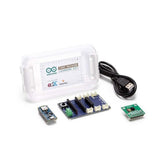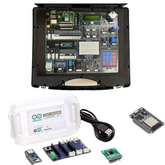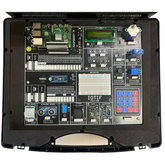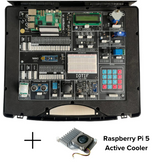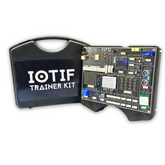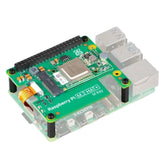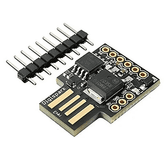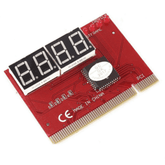The Role of AI and IoT in Modern Robotic Labs
Summary
Modern robotic laboratories have evolved far beyond their mechanically programmed origins. Where once these systems required extensive manual programming and operated in isolation, contemporary AI in robotic labs demonstrates remarkable adaptability and interconnected intelligence.
This evolution has created unprecedented opportunities for researchers and educators who understand both the technical complexities and practical applications of intelligent, connected robotic systems.

Why AI and IoT are Essential for Robotic Labs
The demands of modern research and education have outpaced what traditional robotic setups can deliver effectively.
IoT in robotic labs creates an interconnected ecosystem where every component communicates, shares data, and coordinates actions in ways that isolated systems simply cannot achieve.
Consider the challenges facing today's research facilities:
- Complexity of multi-robot coordination: Modern projects often require multiple robots working simultaneously on different aspects of the same experiment
- Real-time data processing needs: Experiments generate massive amounts of data that require immediate analysis and response
- Remote accessibility requirements: Researchers need to monitor and control experiments from multiple locations
- Precision and repeatability demand: Modern research requires accuracy levels that exceed human capabilities
Artificial intelligence in robotics research addresses these challenges by providing cognitive capabilities that transform mechanical systems into intelligent collaborators.
Rather than simply executing pre-programmed sequences, AI-enabled robots can adapt to changing conditions, learn from previous experiments, and make autonomous decisions based on real-time analysis.
The integration creates a modern robotic lab environment where:
- Robots learn from each experiment, becoming more efficient over time
- Systems predict maintenance needs before failures occur
- Multiple research projects can run simultaneously with coordinated resource allocation
- Data collection and preliminary analysis happen automatically, accelerating discovery cycles
Applications of Artificial Intelligence in Robotic Labs
Machine learning applications in laboratory settings demonstrate remarkable versatility across different research domains. In materials science laboratories, AI-powered systems analyze thousands of chemical combinations, learning which properties lead to desired outcomes and suggesting new experimental directions based on pattern recognition.
The practical applications span numerous areas:
- Computer vision systems enable robots to perform precise assembly tasks, quality control inspections, and microscopic analysis with superhuman accuracy
- Natural language processing allows researchers to interact with robotic systems using conversational commands rather than complex programming languages
- Predictive analytics help optimize experimental parameters and predict outcomes before committing resources to full-scale tests
- Autonomous decision-making algorithms enable robots to adapt experimental procedures based on real-time results
AI-driven robotics projects in educational environments bring abstract concepts into tangible reality.
Students can observe neural networks processing information, watch genetic algorithms evolve solutions, and interact with systems that exhibit emergent behaviors.
This hands-on experience transforms theoretical knowledge into practical understanding.
Intelligent robotic systems working in pharmaceutical research demonstrate particularly compelling applications.
These systems can test drug compounds continuously, analyze molecular interactions, and even suggest new research directions based on pattern recognition across vast databases of chemical knowledge.
Benefits of AI and IoT in Robotic Labs
The integration of these technologies delivers transformative advantages that extend far beyond simple automation. Smart robotic lab technology creates environments where productivity increases exponentially while maintaining precision that surpasses human capabilities.
IoT-enabled robotic systems provide unprecedented visibility into laboratory operations:
- Every sensor reading, robotic movement, and experimental parameter is captured and analyzed
- Real-time monitoring enables immediate responses to changing conditions
- Comprehensive data collection facilitates pattern identification and process optimization
- Historical data enables perfect reproducibility of successful experiments
The benefits of AI in robotics become particularly evident in operational efficiency. Robotics and AI integration facilitates 24/7 operation capabilities, allowing experiments to continue uninterrupted while researchers focus on analysis and strategic planning.
Automated data collection means researchers arrive each morning to find organized results and AI-generated suggestions for next steps.
Cost efficiency represents another significant advantage:
- Long-term labor cost reductions through automation of routine tasks
- Reduced material waste through precision operations and predictive modeling
- Faster time-to-market for innovations through accelerated research cycles
- Predictive maintenance minimizes downtime and extends equipment lifespan
Smart sensors for robotics enable proactive maintenance strategies, identifying potential equipment failures before they occur and scheduling maintenance during optimal times. This approach significantly reduces unexpected downtime and maximizes research productivity.
Challenges in Implementing AI and IoT in Robotic Labs
Despite remarkable benefits, implementing these technologies in robotic laboratories presents significant challenges that organizations must carefully navigate.
The complexity of robotics and AI integration often surprises teams who underestimate the interconnected nature of modern systems.
Technical expertise requirements represent the primary barrier:
- Robotics IoT applications demand professionals skilled in robotics, networking, cybersecurity, and data analytics
- This multidisciplinary skill set is rare and expensive to acquire or develop internally
- Training existing staff requires significant time investment and ongoing education
- Maintaining systems requires continuous learning as technologies evolve rapidly
Cybersecurity concerns become critical when laboratory systems connect to networks and cloud services.
IoT in robotic labs creates multiple potential entry points that malicious actors might exploit, potentially compromising sensitive research data or disrupting critical experiments.
Additional implementation challenges include:
- Initial investment costs can be prohibitive for smaller institutions
- Data management complexity increases exponentially with system integration
- Legacy system compatibility often requires expensive upgrades or replacements
- Regulatory compliance becomes more complex with interconnected systems
Organizations must balance security measures with system functionality while ensuring compliance with industry standards and institutional policies.
Future Trends of AI and IoT in Robotics Research and Education
The future landscape promises even more dramatic transformations as AI and IoT technologies continue evolving. Robotics innovation with AI and IoT is moving toward unprecedented levels of autonomy and intelligence that will redefine laboratory capabilities.
Emerging trends shaping the future include:
- Edge computing integration will enable real-time AI processing directly within robotic systems
- Advanced sensor fusion will provide robots with superhuman perception capabilities
- Collaborative robotics will evolve beyond human-robot interaction to sophisticated multi-robot coordination
- Quantum computing integration may eventually provide exponential increases in processing power
AI and IoT in education applications are expanding rapidly, with STEM education programs incorporating these technologies to prepare students for future careers.
Interactive robotic laboratories will become standard in educational institutions, providing hands-on experience with cutting-edge technologies.
The development of Artificial General Intelligence (AGI) represents the ultimate frontier:
- Robotic systems may eventually possess human-level cognitive abilities across multiple domains
- Laboratory automation could reach levels where human researchers focus primarily on creative and strategic tasks
- Research acceleration could lead to breakthrough discoveries at unprecedented rates
- While still in early research phases, the implications for scientific advancement could be revolutionary.
Bring AI and IoT to Life with our Custom Robotic Labs
Robocraze specializes in designing comprehensive AI and IoT solutions for modern robotic laboratories, creating custom installations that integrate seamlessly with existing infrastructure while providing scalable platforms for future expansion.
Our expert team delivers complete solutions tailored to specific institutional needs, whether establishing new research facilities or upgrading current operations to cutting-edge standards. Contact ... for more details.
Conclusion
The integration of AI and IoT technologies in modern robotic laboratories represents a fundamental shift toward intelligent, connected research environments that are accelerating scientific discovery and educational innovation.
These technologies have transformed laboratory operations from isolated, manually controlled systems into collaborative ecosystems where human creativity combines with artificial intelligence to push the boundaries of what's possible.
From university research facilities advancing scientific knowledge to educational institutions preparing the next generation of innovators, this technological convergence is creating opportunities that seemed impossible just a decade ago.
While implementation challenges exist, the transformative benefits far outweigh the obstacles for organizations willing to invest in their technological future.
As we move forward, the continued evolution of these technologies will create new possibilities for innovation, discovery, and learning that will shape our scientific and educational landscape for generations to come.



